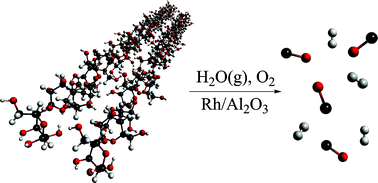Three biomass-to-liquid process steps (volatilization of cellulose, tar-cleaning of organic products, and water-gas-shift of the gaseous effluent) have been integrated into a single autothermal catalytic reactor for the production of high quality synthesis gas at millisecond residence times (∼30 ms). Particles of cellulose (∼300 μm) were directly impinged upon the hot, catalytic bed of Rh–Ce/γ-Al2O3 catalyst on 1.3 mm α-Al2O3 spheres in the presence of O2, N2, and steam in a continuous flow fixed-bed reactor at 500–1100 °C. Complete conversion to gases was observed for all experimental parameters including N2/O2, S/C, the total flow rate of cellulose, and the fuel-to-oxygen ratio (C/O). The addition of steam increased the selectivity to H2 and decreased the selectivity to CO in agreement with water-gas-shift equilibrium. Optimal conditions produced a clean gaseous effluent which exhibited ∼80% selectivity to H2 at a synthesis gas ratio of H2/CO = 2.3 with no dilution from N2 at a fuel efficiency of ∼75%. Carbon-free processing was explained by relating the domain of experimental parameters to the thermodynamic prediction for the formation of solid carbon, CS.

You have access to this article
 Please wait while we load your content...
Something went wrong. Try again?
Please wait while we load your content...
Something went wrong. Try again?


 Please wait while we load your content...
Please wait while we load your content...